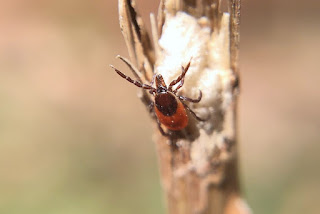 |
| blacklegged (deer) tick. Image: Joyce Sakamoto/Penn State |
It has become
a fad of sorts lately for forest and wildlife managers to extol the value of
controlled fire in controlling tick populations, and by extension Lyme disease
and other tick-borne illnesses. Makes sense to me.
But an
excellent article in the latest issue of Popular Science online entitled – Our Best Bet Against Tick Infestations Might Be Fire –
makes it clear it’s not so simple as setting a fire once in a while. I find it fascinating that we’re paying such
a steep price in public health for disrupting the natural rhythms of
ecosystems. It seems Smokey Bear is not such a great guy after all.
But, perhaps
predictably, scientists are learning that white-tailed deer play a huge role
distributing ticks after fires.
Fire
physically kills most ticks, but the question is, how quickly tick populations
can rebound. One researcher found more than six times the number of tick larva
two years after an area of oak forest in the Ozarks was burned than in nearby
unburned tracts.
The researcher
attributed these strange results to deer. He believes deer were drawn to the
new plant growth that sprouted after the fire. “They move into those recently
burned areas to feed and bring ticks with them,” he said. The trick, he thinks,
is to burn more often. He says that several studies have demonstrated that
fires everyone
to two years decreases tick numbers.
Wonder if
that’s possible on large tracts in Pennsylvania?
JEFF MULHOLLEM, EDITOR
No comments:
Post a Comment